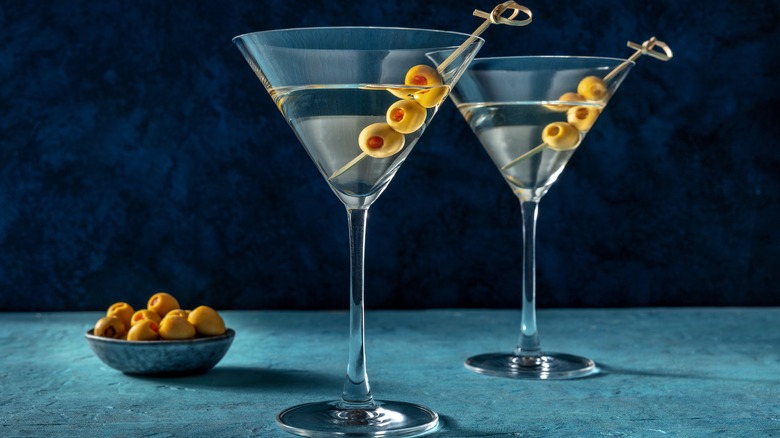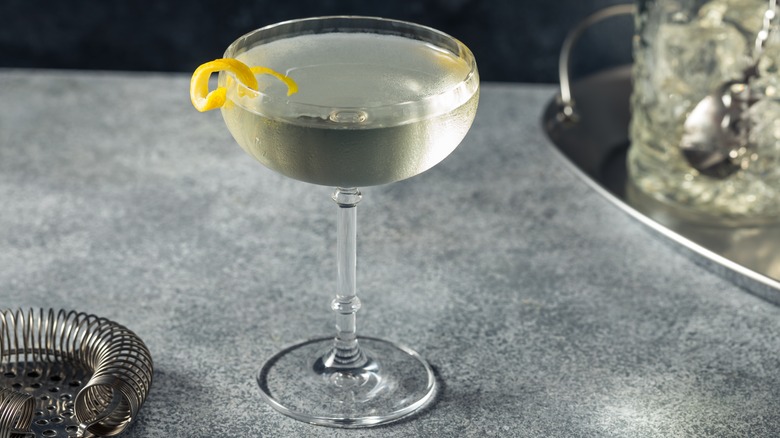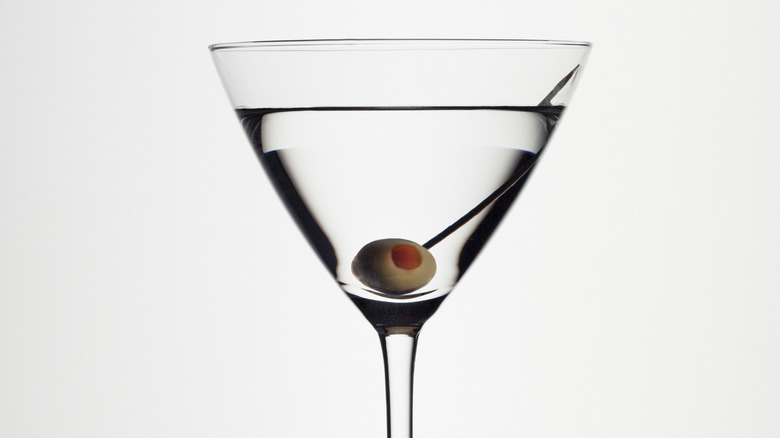The Clever Reason Behind The Shape Of The Iconic Martini Glass
The martini naturally predates the creation of the martini glass. Still, you might be surprised by how long the drink was enjoyed in completely different types of glasses. While we don't know the exact date gin, lemon twist, olive garnish, orange bitters, and vermouth were first stirred together (or is it shaken?), we know martinis existed by the time the 1800s ended.
The martini may have come about thanks to an 1863 vermouth dubbed "Martini." It's also most likely the descendant of the Martinez cocktail, an old-timey category of drink that also spawned the Manhattan. The existence of similar drinks, like the Marguerite and Martineau, muddles this matter. Definitively, though, the martini (both in name and recipe) was officially recorded circa 1888. However, it would be a couple more decades until the martini glass itself took shape. Here's what folks drank martinis in until then, and the clever reason behind the shape of the iconic martini glass itself.
Coupes are a surprisingly practical precursor
In all likelihood, it was the champagne coupe glass that most often contained martinis before their titular glass came along. While not considered ideal for martinis nowadays, coupes do fulfill several nifty functions. The most obvious benefit is their aesthetic; coupes feel fancy and timeless.
Plus, coupes' stems allow the drinker to hold the beverage from below without warming up the liquid with their palm (by placing it right on the other side of the glass). That shallow bowl also comes with its own benefits. First, it gives mixologists plenty of room to add garnishes. Second, it lets the drinker swirl their beverage about. Third, it's not quite top-heavy as other glasses, so people are less likely to spill them. However, coupes' wide mouths do mean bubbly drinks such as champagne lose their carbonation quickly, so it's actually better to put flat drinks like martinis in them.
Strangely, coupes weren't designed with much of this in mind. Instead, the original champagne coupe glass was allegedly modeled to resemble the shape of 18th-century French aristocrat Madame de Pompadour's left breast. The martini glass, alternatively, was indeed developed with practicality as its purpose.
Martini glasses are cool, aromatic, and useful
The champagne coupe is fairly similar to the cocktail glass, which also has a long stem and rounded bowl. The cocktail glass, younger than the coupe yet older than the martini glass, came about at some point during the 1800s, and cocktail glasses are sometimes confused with martini glasses. However, they're smaller and rounder.
Enough of the cocktail glass primer, though; let's get to the heart of this matter. Martini glasses are relatively large and have a unique conical shape up top. There is a luxuriousness to this aesthetic in the presentation, but it began as a way to improve flavors, not appearances. Like coupes and cocktail glasses, the martini glass' long stem allows the liquid to stay colder for longer. Additionally, its V-shaped bowl with a widened brim exposes a greater portion of the liquid to oxygen, which allows the spirits to breathe and become aromatic. Plus, it helps a toothpick of olives stand up rather than fall to the bottom.
Supposedly, the shallowness of this glass also made it useful during the Prohibition era, since it was arguably easier to pour out with haste if imbibers got busted by police at a speakeasy. Whether or not that's true, we know martini glasses caught steam in the Roaring '20s, thanks to the various art exhibits they were featured at. Understanding the proud history behind the martini glass, it is indeed difficult to argue that it's anything but a true work of art.


